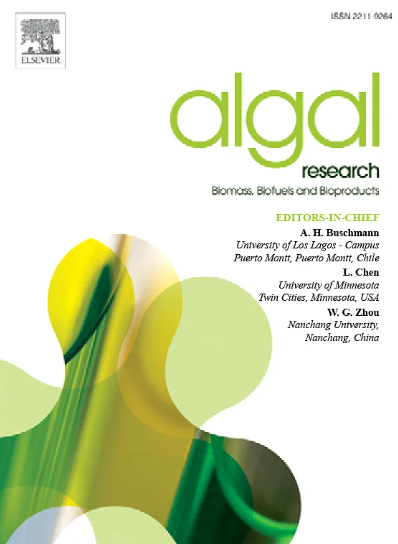Construction of a co-culture system of Bacillus aryabhattai and Desmodesmus sp. and its performance in treating simulated wastewater with high nitrogen and phosphorus
IF 4.6
2区 生物学
Q1 BIOTECHNOLOGY & APPLIED MICROBIOLOGY
Algal Research-Biomass Biofuels and Bioproducts
Pub Date : 2025-04-26
DOI:10.1016/j.algal.2025.104070
引用次数: 0
Abstract
The algae-bacteria co-culture system has emerged as a promising approach for biological wastewater treatment. In this symbiotic system, microalgae supply oxygen through photosynthesis, while bacteria reciprocate by providing inorganic and organic nutrients via metabolic processes, enabling synergistic pollutant removal. However, existing studies remain limited in scope, primarily focusing on specific microbial species. In this study, a novel algae-bacteria co-culture system was established using tolerant and dominant algae and bacteria species isolated from a wastewater treatment plant. The growth characteristics and pollutant removal performance of this system were evaluated in simulated wastewater with high nitrogen and phosphorus levels. The results indicated that Bacillus aryabhattai-Desmodesmus sp. (Ba-Ds) co-culture system achieved optimal removal efficiencies for NH4+-N, total phosphorus (TP), and chemical oxygen demand (COD) under conditions of an algae-bacteria inoculate ratio of 5:1, N/P ratio of 6, and pH of 7. The removal rates reached 30.60 %, 49.30 %, and 93.73 %, respectively. These findings highlight the system's enhanced pollutant removal capacity and demonstrate scalable potential for industrial wastewater treatment applications.

aryabhattai芽孢杆菌与桥单孢菌共培养体系的构建及其处理高氮、高磷模拟废水的性能
藻类-细菌共培养系统是一种很有前途的污水生物处理方法。在这个共生系统中,微藻通过光合作用提供氧气,而细菌通过代谢过程提供无机和有机营养物质,从而实现协同去除污染物。然而,现有的研究范围仍然有限,主要集中在特定的微生物物种上。在本研究中,利用从污水处理厂分离的耐受性和优势藻类和细菌物种建立了一种新的藻类-细菌共培养系统。研究了该系统在高氮、高磷模拟废水中的生长特性和除污性能。结果表明,在接种比为5:1、N/P比为6、pH为7的条件下,aryabhatta - desmodesmus sp. (Ba-Ds)共培养体系对NH4+-N、总磷(TP)和化学需氧量(COD)的去除效果最佳。去除率分别为30.60%、49.30%和93.73%。这些发现突出了该系统增强的污染物去除能力,并展示了工业废水处理应用的可扩展潜力。
本文章由计算机程序翻译,如有差异,请以英文原文为准。
求助全文
约1分钟内获得全文
求助全文
来源期刊

Algal Research-Biomass Biofuels and Bioproducts
BIOTECHNOLOGY & APPLIED MICROBIOLOGY-
CiteScore
9.40
自引率
7.80%
发文量
332
期刊介绍:
Algal Research is an international phycology journal covering all areas of emerging technologies in algae biology, biomass production, cultivation, harvesting, extraction, bioproducts, biorefinery, engineering, and econometrics. Algae is defined to include cyanobacteria, microalgae, and protists and symbionts of interest in biotechnology. The journal publishes original research and reviews for the following scope: algal biology, including but not exclusive to: phylogeny, biodiversity, molecular traits, metabolic regulation, and genetic engineering, algal cultivation, e.g. phototrophic systems, heterotrophic systems, and mixotrophic systems, algal harvesting and extraction systems, biotechnology to convert algal biomass and components into biofuels and bioproducts, e.g., nutraceuticals, pharmaceuticals, animal feed, plastics, etc. algal products and their economic assessment
 求助内容:
求助内容: 应助结果提醒方式:
应助结果提醒方式:


